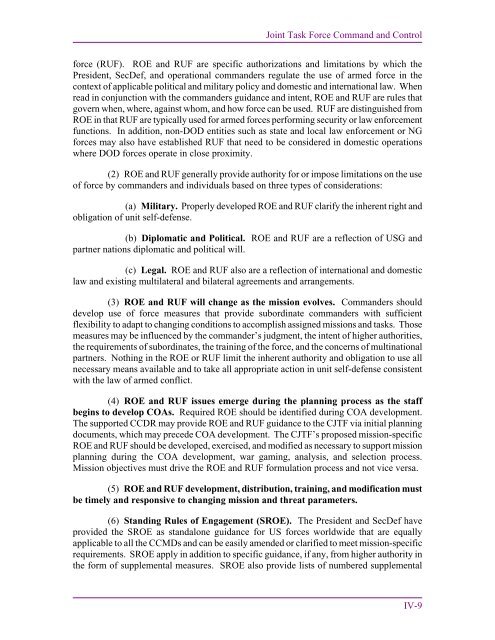JP 3-33, Joint Task Force Headquarters - Defense Innovation ...
JP 3-33, Joint Task Force Headquarters - Defense Innovation ...
JP 3-33, Joint Task Force Headquarters - Defense Innovation ...
Create successful ePaper yourself
Turn your PDF publications into a flip-book with our unique Google optimized e-Paper software.
<strong>Joint</strong> <strong>Task</strong> <strong>Force</strong> Command and Control<br />
force (RUF). ROE and RUF are specific authorizations and limitations by which the<br />
President, SecDef, and operational commanders regulate the use of armed force in the<br />
context of applicable political and military policy and domestic and international law. When<br />
read in conjunction with the commanders guidance and intent, ROE and RUF are rules that<br />
govern when, where, against whom, and how force can be used. RUF are distinguished from<br />
ROE in that RUF are typically used for armed forces performing security or law enforcement<br />
functions. In addition, non-DOD entities such as state and local law enforcement or NG<br />
forces may also have established RUF that need to be considered in domestic operations<br />
where DOD forces operate in close proximity.<br />
(2) ROE and RUF generally provide authority for or impose limitations on the use<br />
of force by commanders and individuals based on three types of considerations:<br />
(a) Military. Properly developed ROE and RUF clarify the inherent right and<br />
obligation of unit self-defense.<br />
(b) Diplomatic and Political. ROE and RUF are a reflection of USG and<br />
partner nations diplomatic and political will.<br />
(c) Legal. ROE and RUF also are a reflection of international and domestic<br />
law and existing multilateral and bilateral agreements and arrangements.<br />
(3) ROE and RUF will change as the mission evolves. Commanders should<br />
develop use of force measures that provide subordinate commanders with sufficient<br />
flexibility to adapt to changing conditions to accomplish assigned missions and tasks. Those<br />
measures may be influenced by the commander’s judgment, the intent of higher authorities,<br />
the requirements of subordinates, the training of the force, and the concerns of multinational<br />
partners. Nothing in the ROE or RUF limit the inherent authority and obligation to use all<br />
necessary means available and to take all appropriate action in unit self-defense consistent<br />
with the law of armed conflict.<br />
(4) ROE and RUF issues emerge during the planning process as the staff<br />
begins to develop COAs. Required ROE should be identified during COA development.<br />
The supported CCDR may provide ROE and RUF guidance to the CJTF via initial planning<br />
documents, which may precede COA development. The CJTF’s proposed mission-specific<br />
ROE and RUF should be developed, exercised, and modified as necessary to support mission<br />
planning during the COA development, war gaming, analysis, and selection process.<br />
Mission objectives must drive the ROE and RUF formulation process and not vice versa.<br />
(5) ROE and RUF development, distribution, training, and modification must<br />
be timely and responsive to changing mission and threat parameters.<br />
(6) Standing Rules of Engagement (SROE). The President and SecDef have<br />
provided the SROE as standalone guidance for US forces worldwide that are equally<br />
applicable to all the CCMDs and can be easily amended or clarified to meet mission-specific<br />
requirements. SROE apply in addition to specific guidance, if any, from higher authority in<br />
the form of supplemental measures. SROE also provide lists of numbered supplemental<br />
IV-9

















